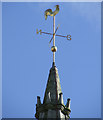1
The Tron Steeple
The steeple is a Category A Listed building http://data.historic-scotland.gov.uk/pls/htmldb/f?p=2200:15:0::::BUILDING:32769 on Argyle Street at Trongate, near Glasgow Cross.
The Tudor Gothic style building immediately to its right is Category C Listed http://data.historic-scotland.gov.uk/pls/htmldb/f?p=2200:15:0::::BUILDING:32770 .
See also
Image
The Mercat Building can be seen in the distance.
Image: © Thomas Nugent
Taken: 7 Oct 2013
0.00 miles
2
Clock tower of the Tron Theatre
The tower belongs to Tron-St Mary's church, which now houses the theatre
Image: © David Smith
Taken: 20 Jul 2017
0.00 miles
5
Tenements on Trongate
At the corner of Trongate and King Street, from Candleriggs.
Image: © Stephen Sweeney
Taken: 9 Dec 2008
0.00 miles
6
The Tron Steeple
On the south side of Argyle Street, near Glasgow Cross. The Tron Steeple is a Category A Listed building http://data.historic-scotland.gov.uk/pls/htmldb/f?p=2200:15:0::::BUILDING:32769 .
See also
Image,
Image,
Image &
Image
Tiny Tots is located in the City Improvement Trust tenement at the corner of King Street and Argyle Street.
Image: © Thomas Nugent
Taken: 7 Oct 2013
0.01 miles
8
Tron Theatre, Argyle Street, Glasgow
Image: © Stevie Spiers
Taken: 4 Jun 2010
0.01 miles
9
Tron Steeple in the Trongate
The site was originally occupied by the pre-Reformation Church of St. Mary, built in 1484. After the Reformation it fell into disrepair, but was restored in 1592. The steeple was added in 1637 and survived a fire which destroyed the building in 1793. The church was rebuilt shortly thereafter. In 2004 it became part of the Tron Theatre which stands behind it.
"At six o'clock in the morning a gun was fired, which intimated that the post-runner (and after 1717 the more expeditious post-horse) had arrived with letters from Edinburgh, and citizens set forth to the little shop where the merchant who acted for £12 a year as postmaster handed out the small supply of correspondence. Thereafter they returned to breakfast, and after a repast on porridge, herring, and ale, took their stand at the shop door, or their seat in the dingy little warehouse, till at half-past eleven the music-bells of the Tron played their pleasant tunes, which, like the St. Giles' bells of Edinburgh, were a signal for merchants and tradesmen to adjourn to their favourite taverns to drink their 'meridian' of ale or brandy - an operation which, the liquor being served in a pewter tankard, was popularly styled 'pewthering'. At mid-day, or one o'clock, having turned the key and shut up their shops, they dined on the inevitable broth and salt beef, or the boiled fowls, bought by the lady near the Cross that morning for threepence each. Dinner over, with its beverage of ale or 'twopenny', the doors of shop and wareroom were reopened till eight o'clock, when the citizens, having finished business for the day, in companies of four or five, resorted to the little tavern rooms, where they drank and gossiped, and discussed the prices of serges, the weft and warp of fine lawn, the arrival of a vessel at Port Glasgow with fir deals from Sweden, or the chances of sale of tallow with Norway. By nine o'clock, however, they usually returned home to supper, to family worship, and to bed." -- H. G. Graham, The Social Life of Scotland in the Eighteenth Century
Image: © kim traynor
Taken: 26 Mar 2012
0.01 miles



















